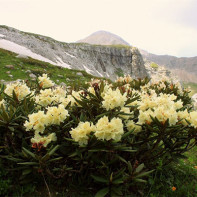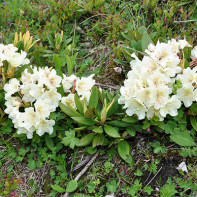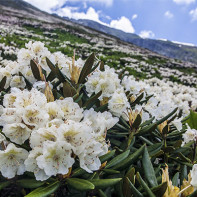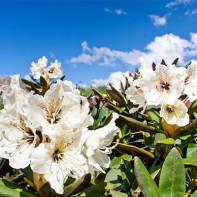Caucasian rhododendron: medicinal properties and contraindications
Caucasian rhododendron is a capricious aristocrat that requires a lot of attention and care. But at home it does not mind both winter bad weather and uncomfortable stony soil. It is ready to sprawl, decorating all the slopes of the mountains with its dense flowering bushes, and not only delight people with its beauty, but also generously share its useful properties.
- Chemical composition
- What it looks like and where it grows
- Gathering and storage
- Therapeutic properties of Caucasian rhododendron
- For Women
- For Men
- Caucasian rhododendron in folk medicine
- Tea from colds
- With insomnia
- For shortness of breath and palpitations.
- Intestinal Problems
- Milk decoction
- For sore throat
- For Pressure
- Alcoholic Tincture for ingestion
- Tincture for rubbing
- Infusion for Women
- For cervical erosion
- Is rhododendron honey useful?
- Contraindications to use
Chemical Composition
Many rumors and legends walk about this shrubby plant. Some are touted as being wonderfully curative while others have warned of its poisonous nature. As always, the truth is in the middle - not without reason rhododendron is recognized by both folk medicine and official medicine.

When people talk about this plant in a negative way, they always mean the andromedotoxin it contains in the first place. This is not a trivial substance, which is considered a natural poison. It belongs to the class of glycosides. If the dose is exceeded, it can cause damage to the body, because it affects the heart by disrupting its receptors. It first has a stimulating effect on the nervous system, then - depressing, and this can end in death. Its effect is in a sense similar to that of a narcotic. But in small doses, andromedotoxin has a calming effect, so the main thing is not to exceed the norm, and then, of course, this substance begins to work for human health.
The useful effect of rhododendron is also due to its constituent tannins. The plant is valued because of their anti-inflammatory and health-promoting effects. Most of them contained in the leaves.
Flavonoids, which are also a component of the chemical composition, also have an anti-inflammatory effect. In addition, they give the plant antioxidant and anticarcinogenic properties.
Essential oils, contained in all parts of the plant, also contribute to the creation of an anti-inflammatory effect, inhibit the reproduction of bacteria and viruses.
The flowers of the plant contain a lot of vitamin C, so it is recommended to gather the medicinal raw material in the flowering period. Then it is particularly rich in this vitamin, without which the body is very difficult to resist viruses, absorb calcium and iron.
Another component of rhododendron - gallic acid, it was used in the medicine of ancient China, it is characterized by antioxidant, antitumor properties. It also has a beneficial effect on the liver, protecting it from negative factors of different origin.
Ursulic acid, also part of rhododendron, helps to burn fat, gives the figure slimness, at the same time stimulates muscle function and inhibits the reproduction of tumor cells.
What it looks like and where it grows
The literal translation of the word "rhododendron" means "rose tree". And it looks no worse than a rose. Rhododendron caucasus is a member of the heath family. Where it grows, it is already clear from the name: its homeland and place of growth is the Caucasus. It is endemic of the Caucasus, which means that the plant is so specific, that in nature lives in a fairly limited area, representing a striking feature of the flora of this natural-geographical zone. It is a typical representative of mountain-meadow subalpine landscape.
Rhododendron is an evergreen plant and not very tall (up to 1-1.5 m). Its stem is recumbent, that is, it grows parallel to the soil surface, covered with a dark brown, almost brown bark. The leaves are oval, slightly elongated along the longitudinal axis. To the touch, the leaves are coarse-skinned, though not thick. They are shiny and smooth, green on top, grayish-red underneath and densely covered, like soft felt, with short hairs.
Flowers are not large, not exceeding 3 cm in diameter. They are arranged in umbrella-shaped inflorescences, in which 9 to 10 corollas are gathered. Their coloring may be snow-white (these can be found mainly on the slopes of the Western Caucasus), and pale cream or light pink (their place of growth - the mountain Gamzachiman in Northern Armenia, Trialet Ridge and Elbrus Mountains, Cheget). But rhododendron with yellow flowers is also found, although much rarer.
Rhododendron blooms in late May. Blossom lasts about a month. When the flowers fade, they are replaced by oval-long-shaped seed capsules, similar in color to the underside of the leaves - gray-rusty, and as felt-like as the underside of the leaf.
Rhododendron roots, due to their surface structure, strengthen the soil layer well on mountain slopes.
Rhododendron differs fairly good winter hardiness and in natural conditions tolerates frost down to -29 degrees, so it began to grow and gardeners in the middle belt of Russia.
In nature, colonies of Rhododendron caucasus are distributed in the foothills and mountains of the Greater and Lesser Caucasus, spread across the Caucasus Mountains to Turkey. Its main settlements are at an altitude of 1600-3000 m. In Russia its usual habitat is Dagestan, Karachay-Cherkessia, North Ossetia, Ingushetia, Chechnya, Kabardino-Balkaria, Adygea and Krasnodar Territory. It also occurs in Altai, but these mountain ranges are not native to the plant: rhododendron was brought there.
And in Abkhazia even laid large plantations of rhododendron: due to the ability of the plant to heal people from its leaves and flowers make medicines.
Collection and storage
Rhododendron leaves and flowers are good for medicinal purposes. The leaves can be harvested all three summer months, but the best period - the time of flowering, simultaneously with the flowers. The most valuable medicinal raw materials will be obtained from plants aged 2-3 years, because by this time they accumulate enough substances with a therapeutic effect.
Hand pluck the leaves and flowers in a basket, then spread them out to dry in a thin layer on clean paper or cloth in a warm and cool place, but not in the sun, because the bright sunlight destroys the useful components they contain and changes the color of raw materials. From time to time the leaves and flowers are stirred so that they dry more evenly.
When the raw material is completely dry, it should break with a slight squeeze. It is put away in glass containers, covered with a lid, so that the raw material does not absorb moisture from the surrounding air. Stored such a drug for no more than 2 years in a dark room at a temperature no higher than 50 degrees.
Medicinal properties of Caucasian rhododendron
Decoctions, infusions and tinctures - three main medicinal forms that use rhododendron caucasian raw material. In only three of these forms it is used for a wide variety of purposes, for a wide range of ailments, and simply as a general tonic. In addition, it is used if you want to tone up, restore the body after a serious illness and stimulate its immune capabilities.
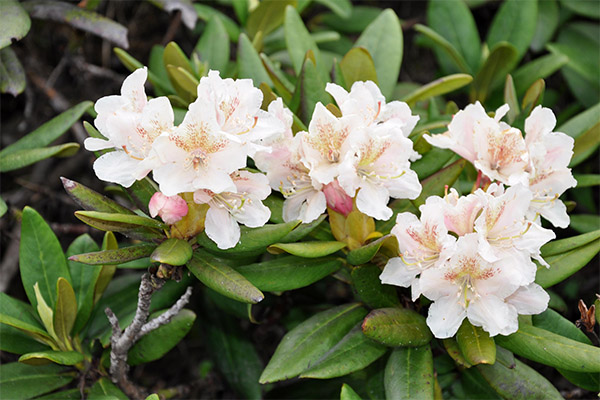
Its therapeutic virtues include diuretic, antipyretic and analgesic effects. Rhododendron caucasus has the ability to normalize body temperature, relieve fever, which is used not only in the treatment of colds, helping to get up quicker, but also to soften the effect of "flushes" in women during menopause. In addition, the plant can increase perspiration, with which toxins and other harmful compounds and substances are eliminated from the body. It is also used to improve conditions in serious cases such as mercury vapor poisoning.
Thanks to its diuretic effect, the plant assists in the rapid removal of edema of both cardiac and renal origin. In addition, this property of rhododendron does not allow deposits to linger in the kidneys, washes away sand and prevents the formation of stones.
Its ability to affect circulation can solve several problems at once, including stimulating the contraction of the heart muscle, increasing blood flow and lowering blood pressure. The plant doesn't just make the heart work, it also encourages it to work harder, fueling and strengthening it. As part of a complex therapy preparations of rhododendron are used not only to treat, but also to prevent the emergence and development of severe cardiac pathologies, as well as to relieve shortness of breath.
The plant is well known for its ability to regulate the nervous system. It is used in the treatment of various kinds of neuralgia, depression, helps to improve human condition and bring behavior to normal with emotional instability, restores the normal sleep and wakefulness.
The anticonvulsant effects of the plant are used to alleviate the course of the disease and improve the condition of the patient suffering from epilepsy. Rhododendron caucasianum, as an adjunct to the main therapy, can seriously reduce the number of seizures and reduce their strength. There have been described cases of complete elimination of seizures when rhododendron is added to the list of remedies, but with a non-serious nature of the disease. An anticonvulsant effect is also used to relieve hand and leg cramps.
Its wound-healing and disinfecting effects, as well as its ability to create barriers to the reproduction of harmful bacteria, are also used in rhododendron-based preparations. This property of the plant is indispensable in the treatment of angina, stomatitis, and dental problems: in particular, mouthwashes for periodontal disease, periodontitis, gingivitis are used. Rhododendron-based products are used by gynecologists when they need to relieve inflammation of the uterus and appendages.
Rhododendron products stimulate fat burning thanks to their influence on metabolism, which helps to lose weight and lower blood cholesterol.
The list of diseases in which compositions and preparations with rhododendron are indicated is extensive: these are diseases of the gastrointestinal tract such as colitis, gastritis and gastroenteritis, insufficiency of the cardiovascular system, rheumatism, osteochondrosis, myositis, bronchitis, asthma, fever and others. It strengthens blood vessels and relieves headaches, improves appetite and brings the liver to its normal state. There are many useful medicinal properties, but do not forget to consult a doctor before taking a rhododendron remedy.
For women
On the eve of menopause, when the bone tissue begins to slowly lose strength, women can pay attention to rhododendron, because its positive effect in the treatment of not only sciatica or osteochondrosis, but also other pathologies of the bone and connective tissue has been proven.
Means made on the basis of rhododendron leaves are used in the treatment of infertility. Positive results can be achieved because decoctions and tinctures help eliminate inflammation in the uterus and appendages. It is possible to treat women's problems such as cervical erosion.
In addition, decoctions of medicinal raw materials relieve pain in the abdomen during menstruation. During menopause, the plant helps relieve the discomfort of temperature spikes and the so-called hot flashes typical of this period.
For men
Rhododendron caucasianum also serves men well. By improving the functioning of all body systems, including circulation, it helps relieve inflammation in the prostate gland. Also in his power to increase manhood - not without reason Caucasian long-livers in areas where it grows Rhododendron, a long vigor retain and lead an active life in all senses.
Caucasian rhododendron in folk medicine
Folk medicine has learned to use both leaves and dried flowers of the shrub. This raw material is used to prepare medicines in different forms. Rhododendron is brewed and drunk as a tea and as a decoction of dried raw materials, as well as preparing alcoholic tinctures. It is used to treat fevers, epilepsy, headaches and insomnia, to calm irritability and nervousness, to relieve rheumatism, to treat gout and to restore intestinal function in dysentery and acute and chronic colitis. It is also used as a cardiac and diuretic.
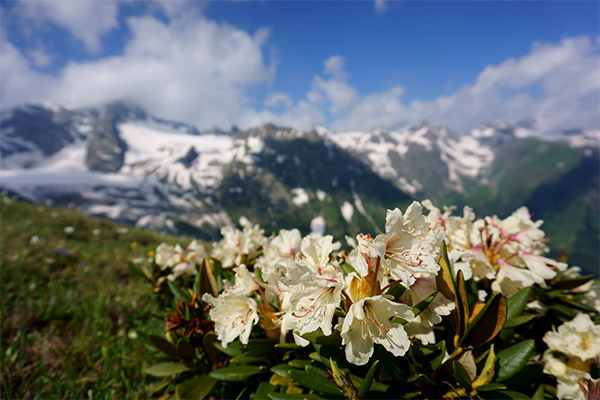
Herbalists use rhododendron for every problem: for example, it is recommended as a remedy for colds and strengthens the body. Rhododendron honey is also recommended for this purpose. Alcoholic tincture in small quantities is prescribed for tachycardia and shortness of breath, decoction of the leaves reduce high blood pressure, it is used for douches for female problems - in particular, for cervical erosion, as well as for male diseases - such as prostatitis.
Trusting the recipes of folk healers, we must not forget: before prescribing yourself a remedy from rhododendron, it is necessary to consult a doctor.
Tea for colds
To brew a healing tea, half a teaspoon of crushed dried leaves of Caucasian rhododendron to pour 250 ml (about a cup) of boiling water and set aside for 10 minutes to stand. Pour a glass of milk into the tea and heat to a boil, but do not boil. Drink this tea in the same way as ordinary tea, adding sugar or honey to taste. This tea will quickly put you on your feet when you have a cold or restore your strength after a serious illness.
For insomnia
Boil 250 ml of water, pour water over crushed dried rhododendron leaves (1 teaspoon), infuse. After cooling and strain to drink 3 times a day, 20 ml. It has a sedative effect if weary cramps, insomnia, or increased irritability. At the same time the composition will help against headaches.
For shortness of breath and palpitations.
Crush the dried leaves of rhododendron. In a small thermos pour a teaspoon of healing plant. Pour there the same 250 ml of just boiling water. Strain after a two-hour infusion and drink 2-3 times a day for 20 ml. Such an infusion is used by those who suffer from cardiovascular insufficiency, it reduces shortness of breath, normalizes the heartbeat, removes edema.
With intestinal problems.
A teaspoon of medicinal raw materials poured into a mug, pour a glass of just boiled water, insist 2 hours. After straining, take 20 ml 2-3 times a day, after a meal. This infusion has proven to reduce the symptoms of chronic inflammation of the intestines, both small and large, and the treatment of dysentery.
Decoction with milk
For this remedy, you will need 4 whole dried leaves of the plant and 2 fresh, just picked. Put them in an enamel pan or ladle of at least 0.7 liters, pour 200-250 ml of boiling water. Place on low heat and boil for 5 minutes under a lid. Then turn off the heat for 5 minutes, and then add 200-250 ml of milk and heat again. Once it boils, you can take off the stove. Drink this decoction by the cups - like regular tea, but not sweet: the drink gets an interesting taste if you pour pepper and salt into it. The drink is good for the first signs of a cold, fart in the nose and throat, as well as to soothe in a stressful situation.
For angina
Prepare 20 grams of dried medicinal raw materials, pour it into a clay mug with thick walls. Pour a glass of freshly boiled water, stir quickly, cover and wrap with a thick terry towel. Wait two hours and take it. Drink a little, but often - 5 times a day, 1 tablespoon. Such a drink will help with sore throat. If you rinse a sore throat with it, it will speed up the recovery. Drinking the medicine and gargling continue until the pain stops. Such gargles also help to relieve inflammation in stomatitis, gum disease and eliminate bad breath.
For Pressure
You can treat high blood pressure with an infusion of one dry leaf of the plant, poured with boiling water (250 ml). Brewing time - 30 minutes, after which you need to filter the infusion and drink. Norm - 1 tablespoon 3 times a day before meals.
Alcoholic tincture for oral administration
This tincture is not suitable for making dried raw materials, you must be freshly harvested rhododendron leaves and flowers. They need to cut as finely as possible - then useful substances will be released more quickly and in full in the finished product. 20 g of raw materials put in a dark glass jar, pour a glass of good vodka and cover. In a dark, unheated place, insist the mixture for at least two weeks.
At the end of this period, strain thoroughly, cork and store better in the refrigerator. Use 2-3 times a day, for which dilute in half a glass of water 15-20 drops of tincture. It has a positive effect to get rid of tachycardia and shortness of breath. Also recommended to reduce swelling and high blood pressure. If you infuse only one flower of the plant, the finished composition can be used as a sedative before bedtime.
Tincture for rubbing
To prepare a tincture for rubbing, also dried medicinal raw materials are good. To do this, take 2 tablespoons each of dried leaves and the same number of flowers, which must be crushed - you can just partially break it with your hands and crush with your fingers to powder. Then add 200 ml of vodka and put in a dark room to stand. While it insists, occasionally shake the vessel with the mixture. After two weeks the composition is ready. You can rub them in painful places with sciatica, myositis, polyarthritis, etc.
Infusion for women
To solve a whole complex of women's problems will help the reception of infusion, prepared from the leaves. Infertility and inflammation in the uterus are treated by using 2-3 times a day 1 tablespoon of the product, which is prepared by brewing 1 teaspoon in a glass of boiling water. This composition is also used for cervical erosion, diluting the infusion with boiled water to make 1 liter of liquid, then sprinkling with the resulting remedy.
For cervical erosion
Another decoction for women. Take 1 teaspoon each of dried, crushed rhododendron and calendula in equal parts. Pour the dry mixture with a glass of boiling water and leave under a lid for half an hour. Use for irrigation twice a day until recovery.
Is rhododendron honey useful?
There are many legends about rhododendron honey. It is even said to be poisonous, to the point of creating delusions and hallucinations. The ancient Greek general and writer Xenophonte described an incident that happened during one of his marches, when his army stopped for the night in a place known for its excellent beekeepers and their honey. Warriors did not restrain themselves and pounced on honey - ate as much as each could. But soon one by one they felt sick, and one by one they all fainted. It was not until the next twenty-four hours that they began to regain consciousness, but they were still in a twilight state. It was not until the end of the fourth day that absolutely everyone - alive and well - was able to continue their trek. It turned out that the honey that knocked the whole army out of the saddle was collected by bees from the rhododendrons that grew luxuriantly around them.
In the valley of Batumi, not far from the place described by Xenophonte, a similar honey was found again, but later - in 1877.
Today it has been determined that bees collect this extravagant honey from the flowers of the yellow rhododendron, because it contains a high percentage of andromedotoxin. This may provoke unpleasant symptoms, and a man who has had enough of it is not immune to headaches, vomiting and a blackout.
But as early as the last century, the Russian botanist Robert Regel found that honey is in fact perfectly usable and not poisonous. It tastes a little unusual because it is not very sweet and slightly tart, and its color is peculiar - beige. Some indigenous Caucasian peoples living in the mountains heat honey up to 46 degrees, in which the poisonous substances decompose, while the taste and useful properties remain unchanged.
Rhododendron honey is great for treating colds, soothing coughs of bronchitis, and easing the course of acute respiratory infections. Choosing honey as a treatment, should not be carried away with its excessive use. The maximum dose - 2 tablespoons per day. Otherwise, both allergic reactions and problems with the nervous system are possible.
Contraindications for use
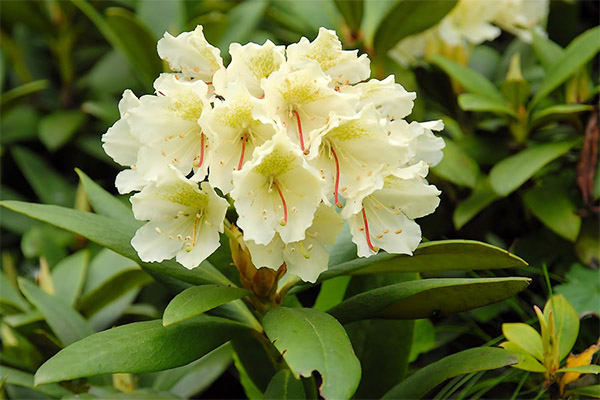
The first and most important condition for taking remedies based on Rhododendron caucasianum is to remember that this plant is toxic. With an overdose, the consequences are unpredictable, insomnia or diarrhea being the most harmless of them. Tachycardia, kidney disorders with urinary retention, and even hallucinations are possible. Do not exceed the norms of consumption of decoctions and proportions in the preparation of healing drinks. It is better to take a slightly lower dose than to take a risk.
Never give rhododendron potions to children, especially young children. And during pregnancy and lactation rhododendron decoctions, infusions and tinctures - taboo! Do not try them under any circumstances. And the honey, collected by bees from this plant, is not forbidden to pregnant women. A spoonful of honey before going to bed will not be harmful.
Rhododendron honey is also contraindicated to people with serious kidney problems, as well as those with necrotic tissue changes.
And the last weighty prohibition: if there is an allergy to any component in the composition of rhododendron, you can not take remedies prepared on the basis of this plant.
«This could cause irritation, which could lead to mucous membranes and other deformities: All information on this site is provided solely for introductory This site contains information for informational purposes only. Before applying any recommendations, consult a health care professional. specialist. Neither the editors nor the authors shall be liable for any possible harm caused by materials."

